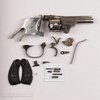Fabricating the trigger return spring
You would think that a simple spring would be easy to make. Well, it isn't so easy if you don't have a broken one to replicate. I first tried to make a V spring like the S&W or even the H&A's use. But I was unsuccessful. Then I found the picture of the parts kit in one of the above posts and was able to see that it was a leaf spring. So I tried to make that out of an old mainspring I had but again, I was unsuccessful. Wolff Springs sells a package of trigger return springs made for H&R and other top break revolvers. So I ordered them. 4 copies of 3 different sized trigger return springs.


I picked the smallest/thinnest spring to make the trigger return spring. The spring had to be 'narrowed' to fit in the slot in the frame. I used the factory drilled hole that had to be reamed to fit the screw and fitted the length. Using the factory drilled hole was a tactical error becuase when I fitted the length I was taking off part of the 'curve' of the spring. One has to get the length just right to hit the exact spot on the trigger to return the trigger. Too long and the spring would bind on the trigger. Too short and it wouldn't reach the exact point on the trigger and return the trigger. Testing of the new spring showed it was just strong enough to return the trigger without the cylinder installed. It feal very weak. Once the cylinder was installed the drag from friction on the trigger/hand was enough to make the trigger return spring unreliable for returning the trigger. It was just too weak. So if the smallest/thinnest spring was too weak to reliably return the trigger, I used the biggest/thickest spring in the Wolff kit and made another. It was a little bit easier now that I had one that was the right shape to basically copy. It still felt weak but was strong enough to over come the friction/drag with the cylinder installed. Unfortunately when the double action sear was installed the spring was again too weak to reliably return the trigger. The double action sear is another piece loosely attached to the trigger guard/trigger and is just a 'bugger' to install. Now I was sure none of the springs in the Wolff kit would work. On a lark I put both the orignal spring I had made and the second spring in and guess what? It worked. The trigger return now felt like it should and it was plenty of force to overcome the drag from the cylinder/trigger/hand/double action sear.
Here is a picture of the second spring I made. Notice there are two holes in it. The first spring I made looked just like it but used the factory hole.

Now, drilling a hole in hardened spring steel isn't easy. I suspect the correct way to do it would be to anneal the spring, drill the hole and re-harden and temper. Although I probably could have figured it out, I wasn't comfortable with that process. So a slow drill, sharp tungsten/carbide drill bit and tons of cutting oil did the trick.
But I had to hold the spring on the drill press. Keep in mind that I have a Harbour Freight drill press that I don't trust to hold a precision alignment. Getting the drill table perpendicular to the drill bit is an eyeball operation. That in and of itself took quite a while. But how to hold this tiny spring while I drill on it for minutes at a time? I had to make a 'jig' to hold it. Two pieces of brass sheet. One carved out to receive the spring and another full sheet underneath the first sheet to form a bottom to hold the spring in place from the bottom. It work fine:


Now, unless I decide to re-nickel this revolver (and I might as a practice piece), the trigger guard, return spring, and double action sear will never come out of this revolver as long as I own it. It takes 3 hands and holding your tongue in just the right spot to put them all together at the same time. And a slave pin is necessary. Here are the parts/pieces involved
Notice on the right side the double action sear is inside a recess in the trigger guard. The double action sear is held in place by a pin through the frame, then through the trigger guard, then through the double action sear. In order to keep the double action sear in place during assembly I filled the recess the sear resides in with grease to generally hold it in place, placed the sear in the trigger guard, made a slave pin that was just narrower than the trigger guard all to hold the sear in place during installation. Installation was to insert the trigger guard screw, place the trigger return spring on the screw, start the screw just barely into the trigger guard then finagle the trigger guard into place then drive the full length trigger guard retaining pin through the frame, through the trigger guard and then the double action sear and out the other side of the frame. Needless to say that took more than one try to accomplish.

And assembled

I have not had the trigger or the hammer out of this revolver. As a solid frame I can't tell how difficult it would be to reinstall them. Plus, there is a piece of the frame that looks like a filler for a slot to install/remove the hammer. But there are no retaining pins to hold it in place. It show up better in one of the auction pictures before it was cleaned of rust.


































